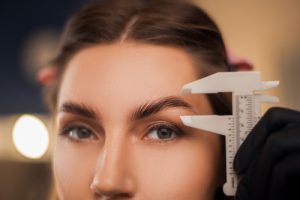 As we age, one of the first areas to show signs of aging is often the forehead and brow region. A brow lift, also known as a forehead lift, is a cosmetic procedure designed to address sagging brows and improve the overall appearance of the forehead area. By raising the brow, this procedure can help create a more youthful and refreshed look. Consulting with an experienced oculoplastic surgeon can provide you with a better understanding of whether a brow lift is right for you. Khan Eyelid and Facial Aesthetics, led by oculoplastic and reconstructive surgeon Dr. Tanya Khan, provides brow lift to patients in Plano, Dallas, Austin, Texas, and surrounding locations.
As we age, one of the first areas to show signs of aging is often the forehead and brow region. A brow lift, also known as a forehead lift, is a cosmetic procedure designed to address sagging brows and improve the overall appearance of the forehead area. By raising the brow, this procedure can help create a more youthful and refreshed look. Consulting with an experienced oculoplastic surgeon can provide you with a better understanding of whether a brow lift is right for you. Khan Eyelid and Facial Aesthetics, led by oculoplastic and reconstructive surgeon Dr. Tanya Khan, provides brow lift to patients in Plano, Dallas, Austin, Texas, and surrounding locations.
Understanding the Brow Lift Procedure
A brow lift is a surgical intervention focused on elevating the brow to minimize the appearance of wrinkles, frown lines, and sagging skin. The procedure typically involves making incisions either at the hairline or within the scalp, through which the surgeon lifts and repositions the underlying tissue and muscle. This not only elevates the brow but also smooths out wrinkles on the forehead and diminishes frown lines between the eyebrows. The end result is a rejuvenated, more youthful appearance. Various techniques can be employed, such as the traditional coronal brow lift, the less invasive endoscopic brow lift, or the temporal brow lift, each with its own incision patterns and recovery profiles. During the surgery, advanced tools and methods are used to ensure precision and minimize scarring. Anesthesia options are also available, depending on the complexity of the procedure and patient preference. Your surgeon will select the most appropriate technique based on your facial anatomy and aesthetic goals. Post-surgery, patients often experience an immediate improvement in the elevation and smoothness of their brow area. While some swelling and bruising are common, these typically subside within a few weeks, revealing the full benefits of the procedure. It’s important to follow your surgeon’s post-operative care instructions to achieve the best possible outcome.
Who Is a Good Candidate for a Brow Lift?
Ideal candidates for a brow lift are individuals who are troubled by sagging brows, pronounced forehead lines, or heavy lids that can even impair vision. Those who are physically healthy and non-smokers generally fare better in both the surgery and recovery process. A brow lift might be suitable for you if you have a persistent tired or angry expression due to the position of your eyebrows. People with realistic expectations about the surgical outcomes and who understand the potential risks and benefits make the best candidates. It’s essential to have a clear communication with your surgeon about your goals to ensure that a brow lift is the right choice for you.
Consultation with an Oculoplastic Surgeon
A consultation with an oculoplastic surgeon is a crucial first step before proceeding with a brow lift. During this meeting, the surgeon will perform a thorough examination of your facial anatomy to understand the underlying factors contributing to sagging brows and forehead lines. They will inquire about your medical history, any previous surgeries, and current medications to ensure that you are a suitable candidate for the procedure.
The surgeon will also take time to discuss your aesthetic goals, asking detailed questions to fully grasp the look you hope to achieve. Visual aids, such as before-and-after photos of previous patients, may be used to give you a realistic idea of the possible outcomes. This dialogue allows the surgeon to set realistic expectations and ensure that your goals align with what the procedure can accomplish.
You will also learn about the various techniques available for a brow lift, including the traditional coronal brow lift, endoscopic brow lift, and temporal brow lift. The surgeon will explain the advantages and disadvantages of each technique, helping you make an informed decision about which method is best suited to your needs.
During this consultation, the surgeon will outline the steps involved in the procedure, the type of anesthesia that will be used, and what you can expect during the recovery period. They will also address any concerns you might have about the surgery, including potential risks and complications.
Lastly, this meeting is an excellent opportunity to build a rapport with your surgeon, ensuring that you feel comfortable and confident in their abilities. This trust is essential for a successful surgical outcome and a satisfying patient experience.
Types of Brow Lift Techniques
There are several techniques used in brow lift surgeries, each tailored to address specific concerns and patient needs. The traditional coronal brow lift involves a single, continuous incision made from ear to ear across the top of the head within the hairline. This method allows for significant lifting and is particularly effective for those with deep forehead wrinkles and drooping brows.
The endoscopic brow lift, on the other hand, is a less invasive option that uses smaller incisions within the scalp and an endoscope to guide the surgeon in lifting the brow. This technique results in minimal scarring and a shorter recovery time, making it an attractive choice for many patients.
Another approach is the temporal or limited incision brow lift, which involves incisions near the temples. This technique primarily targets the outer parts of the brow and is beneficial for patients looking to correct mild to moderate sagging without extensive surgery.
Each technique has its own set of benefits and potential drawbacks, such as varying degrees of scarring, recovery times, and the extent of correction achievable. Discussing these options in detail with your oculoplastic surgeon will help you understand which method aligns best with your aesthetic goals and medical considerations.
Preparing for Your Brow Lift Surgery
Proper preparation is key to a successful brow lift surgery and smooth recovery. Begin by discussing your medical history, medications, and any previous surgeries with your oculoplastic surgeon, as this information is vital for planning your procedure. Your surgeon will likely advise you to avoid certain medications and supplements that can increase bleeding risk, such as aspirin or anti-inflammatory drugs, for a specified period before surgery.
If you smoke, it’s essential to stop several weeks before the surgery, as smoking can impede healing and increase the risk of complications. Arrange for someone to drive you home after the procedure and to assist you for the first 24-48 hours, as you may experience some initial discomfort and limited mobility.
Creating a comfortable recovery space at home is also beneficial. Stock up on necessary supplies such as gauze, cold compresses, and any prescribed medications. Placing these items within easy reach can help minimize movement and promote rest.
Follow any fasting guidelines provided by your surgeon if general anesthesia will be used. Wearing loose, comfortable clothing on the day of the surgery will make changing easier post-procedure. Adhering to these preparatory steps will contribute to a more efficient surgery and a smoother recovery journey.
The Recovery Process
The Recovery Process: After a brow lift, patients can expect some swelling and bruising, which typically subside within a few weeks. To manage these symptoms, your surgeon will recommend keeping your head elevated and applying cold compresses as needed. Pain medication may be prescribed to help alleviate any discomfort during the initial recovery period.
It’s crucial to avoid strenuous activities and heavy lifting for several weeks to promote proper healing. You should also refrain from bending over or any activities that could increase blood pressure to your face, as this can exacerbate swelling. Sleeping with your head elevated on pillows can further reduce swelling and enhance comfort.
Your surgeon will likely schedule follow-up appointments to monitor your progress and address any concerns. Stitches or staples are usually removed within a week to ten days, depending on the type of brow lift performed. It’s essential to follow all post-operative care instructions closely to ensure a smooth recovery and optimal results.
You may notice some numbness or tingling around the incision sites, which is generally temporary and should gradually improve. Keeping the surgical area clean and protected from direct sunlight is also vital for proper healing and minimizing scarring. Most patients feel ready to return to work and social activities within 10 to 14 days, though full recovery can take a few months.
Results and Longevity of a Brow Lift
The outcomes of a brow lift can significantly enhance your facial appearance, providing a more youthful and refreshed look. While the effects are long-lasting, the duration can vary based on factors such as age, skin type, and overall health. Most patients find that their results persist for several years before natural aging processes gradually become apparent again. To maintain the best results, it’s crucial to follow your surgeon’s advice on post-operative care and sun protection. Additionally, adopting a healthy lifestyle that includes a balanced diet and regular exercise can help prolong the benefits of the procedure. Regular check-ups with your oculoplastic surgeon will help monitor your progress and address any concerns, ensuring that you continue to enjoy the improvements from your brow lift for as long as possible.
CONTACT Khan Eyelid and Facial Aesthetics AND OCULOPLASTIC & RECONSTRUCTIVE SURGEON DR. TANYA KHAN TODAY TO SCHEDULE AN APPOINTMENT
For more information about procedures and treatments at Khan Eyelid and Facial Aesthetics by Ophthalmic surgeon Dr. Tanya Khan. Click here to contact us.
Taking patients from in and around Dallas, Plano, Fort Worth, Grapevine, Garland, Mesquite, Carrollton, Irving, Frisco, Texas and more.









Schedule a Consultation: 972-EYE-LIDS (393-5437)